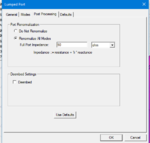shanmei
Advanced Member level 1

If an antenna is terminated at 50 ohms, then the S11 is less than 0DB.
If an antenna is terminated at a complex impedeance (50-500*i) ohm and the termination is passive as well , is it possible that the S11 is greater than 0dB for certain frequency range? Thanks.
If an antenna is terminated at a complex impedeance (50-500*i) ohm and the termination is passive as well , is it possible that the S11 is greater than 0dB for certain frequency range? Thanks.
Last edited:






